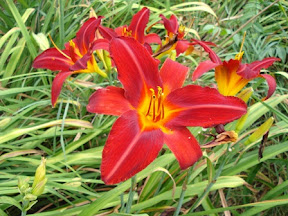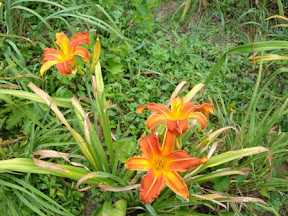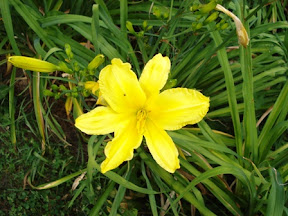Several of us on my street had nice specimens of the redbud cultivar 'Forest Pansy', the one whose leaves hold a deep red color all season long. For no reason anyone could guess Jackie's tree failed to bloom or leaf out this spring and was finally pronounced past help. I looked out last week and saw that mine had turned completely
Monday, July 16, 2007
Virginia soil
Every one of my acid loving plants has started to turn yellow, a condition called chlorosis that usually means the soil is not acid enough to allow them to absorb iron. I had applied HollyTone and sulfur to the base of each earlier in the season but my next door neighbor pointed out that the roots have probably spread out further and the feeder roots are hitting our limestone soil. I've scratched the mulch away and applied the same mix at the drip line and watered it in. I hope that's the only problem. My native azaleas, mountain laurels and blueberries are all affected.
8/07/2007 Update:
I think this is working. At least some of the plants are starting to green up again!
8/07/2007 Update:
I think this is working. At least some of the plants are starting to green up again!
Passion flower
This is a new thing for me. It's Passiflora incarnata, called Maypop because its habit is to die to the ground in the winter and then pop up all over the place in May. I planted it last year and it performed as promised. It's growing up through the branches of a Carolina silverbell (Halesia tetraptera). Here are the first flowers I've seen. It is caterpillar food for Zebra Longwing and Variegated and Gulf Frittilary butterfly larvae.
Viburnum berries ripening
Friday, July 13, 2007
Planting a prairie
I'm nursing my trays of seedling prairie plants, trying to get them through the summer heat until I can plant them out in September. I will then fill in with seeds of native grasses and forbs. When I started the project I knew that it was going to take at least a full year to establish the bed and get the weeds under good control. I hoped to get a good start by planting seeds in trays and overwintering them since many need cold to germinate and spend most of their first year growing a root system. I have some good sized plants blooming from the first winter and trays of very insignificant looking seedlings from this past winter. I'll plant them out but on the whole, I think I invested a lot more time and effort than the result justified. I learned some things along the way but if I had it to do over, would probably just wait until the bed was ready and sow seeds directly.
Some problems I encountered:
My temporary cold frames were constructed from half inch PVC pipe covered with plastic sheeting. The hoops had a rather flattened profile that let snow and water collect and collapse the whole thing. More than once I was out in the sleet cleaning them off.
Then I left the covers on too long and I think it got too hot. Many seedlings fried and died.
The cats thought the cold frames made a cozy place for a springtime nap. Having large hairy beasts lying on them didn't do the seedlings any good either.
Summer doldrums
The daylilies are starting to make a nice splash of color along the fence.




Hot and dry. Virginia in the summer is hot and dry. The roses look sort of discouraged, the weeds have taken over the blueberry bed. I will spend the weekend weeding and watering.
My sister sent me home from Cape Cod with a rose and some irises that were not doing well in a shady bed. The rose is Mountbatten, sold by Heirloom as Lord Mountbatten. I had one that died so am glad to have a replacement. I'll nurse it along in a pot until the weather cools a bit in September. It's a lovely thing, full yellow flowers with the edges of the petals just touched with pink.
Hot and dry. Virginia in the summer is hot and dry. The roses look sort of discouraged, the weeds have taken over the blueberry bed. I will spend the weekend weeding and watering.
My sister sent me home from Cape Cod with a rose and some irises that were not doing well in a shady bed. The rose is Mountbatten, sold by Heirloom as Lord Mountbatten. I had one that died so am glad to have a replacement. I'll nurse it along in a pot until the weather cools a bit in September. It's a lovely thing, full yellow flowers with the edges of the petals just touched with pink.
Subscribe to:
Posts (Atom)


